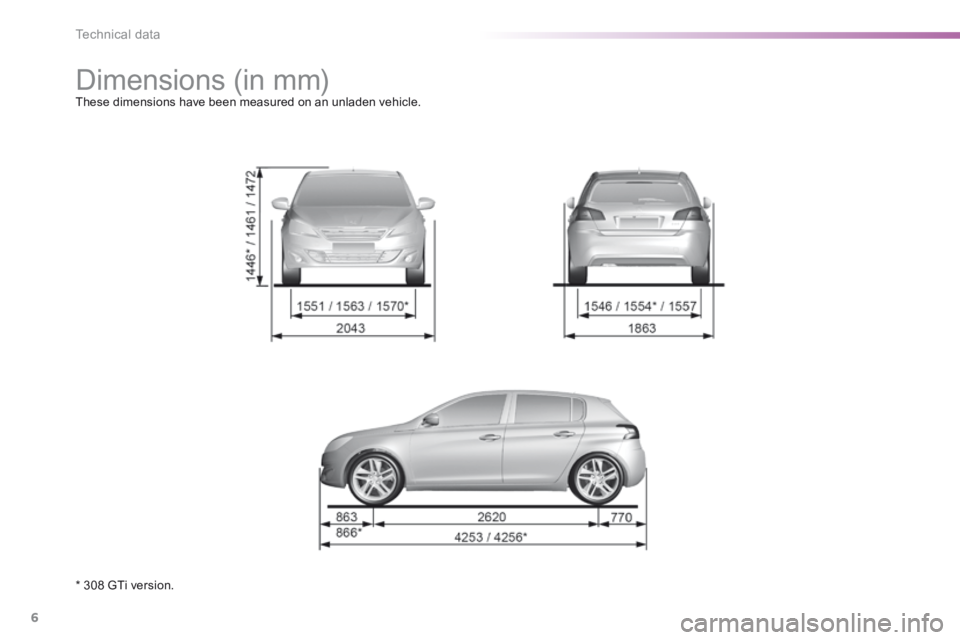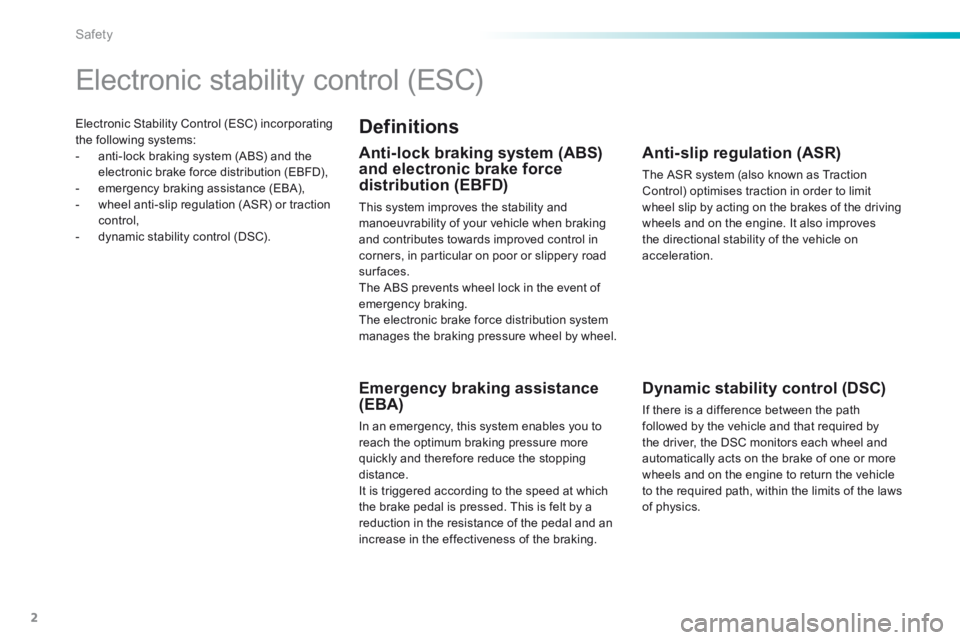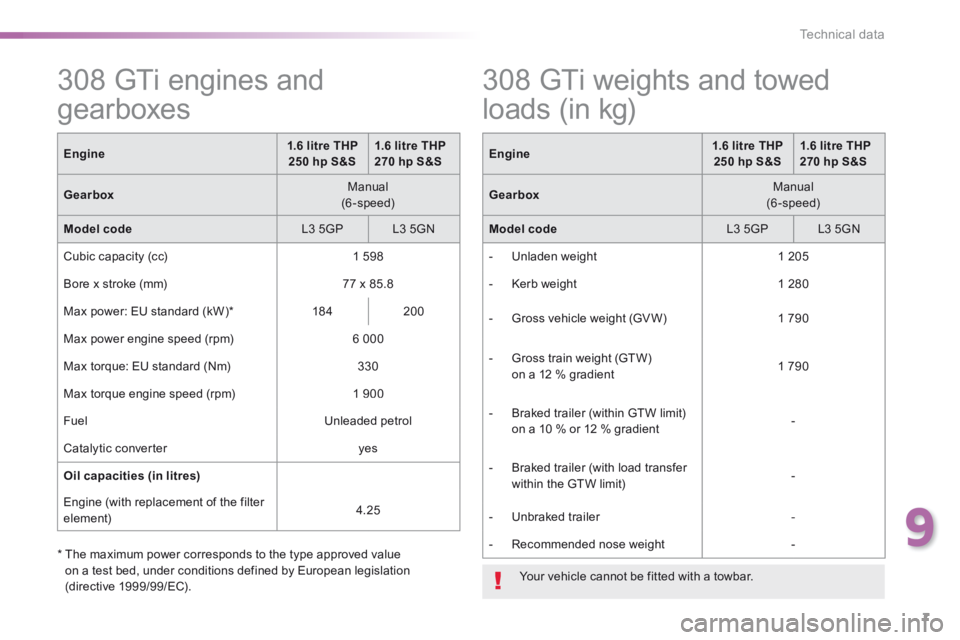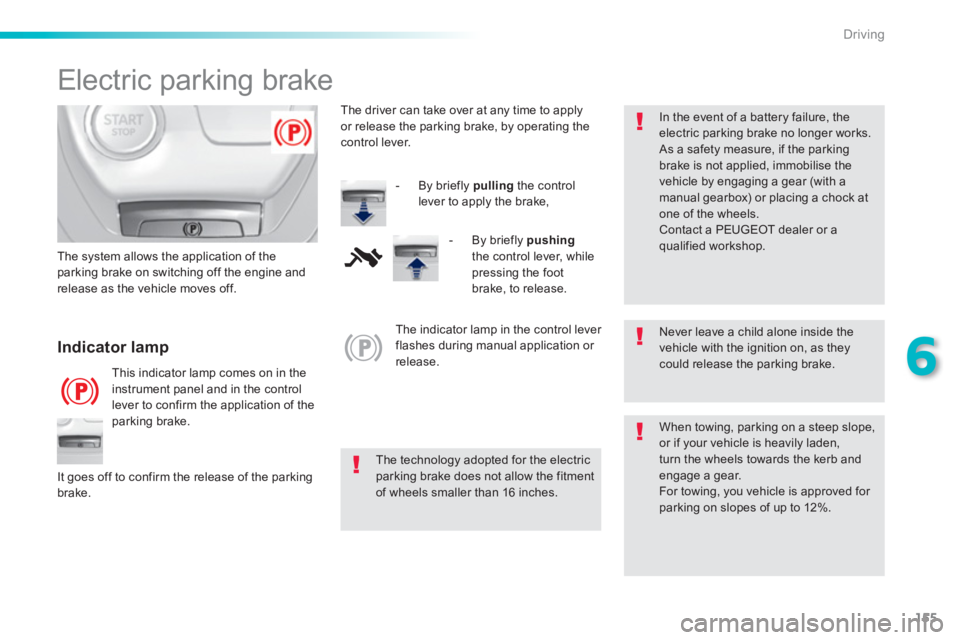Peugeot 308 2015 Owner's Manual
Manufacturer: PEUGEOT, Model Year: 2015, Model line: 308, Model: Peugeot 308 2015Pages: 416, PDF Size: 11.81 MB
Page 411 of 416

6
Technical data
308GTi_en_Chap09_caracteristiques-techniques_ed01-2015
Dimensions (in mm) These dimensions have been measured on an unladen vehicle.
* 308 GTi version.
Page 412 of 416

2
Safety
308GTi_en_Chap06_securite_ed01-2015
Electronic Stability Control (ESC) incorporating the following systems: - anti-lock braking system (ABS) and the electronic brake force distribution (EBFD), - emergency braking assistance (EBA), - wheel anti-slip regulation (ASR) or traction control, - dynamic stability control (DSC).
Electronic stability control (ESC)
Definitions
Anti-lock braking system (ABS) and electronic brake force distribution (EBFD)
This system improves the stability and manoeuvrability of your vehicle when braking and contributes towards improved control in corners, in particular on poor or slippery road surfaces. The ABS prevents wheel lock in the event of emergency braking. The electronic brake force distribution system manages the braking pressure wheel by wheel.
Emergency braking assistance (EBA)
In an emergency, this system enables you to reach the optimum braking pressure more quickly and therefore reduce the stopping distance. It is triggered according to the speed at which the brake pedal is pressed. This is felt by a reduction in the resistance of the pedal and an increase in the effectiveness of the braking.
Anti-slip regulation (ASR)
The ASR system (also known as Traction Control) optimises traction in order to limit wheel slip by acting on the brakes of the driving wheels and on the engine. It also improves the directional stability of the vehicle on acceleration.
Dynamic stability control (DSC)
If there is a difference between the path followed by the vehicle and that required by the driver, the DSC monitors each wheel and automatically acts on the brake of one or more wheels and on the engine to return the vehicle to the required path, within the limits of the laws of physics.
Page 413 of 416

3
6
Safety
308GTi_en_Chap06_securite_ed01-2015
Anti-lock braking system
(ABS) and electronic brake
force distribution (EBFD)
Operation
In emergency braking, press very firmly without releasing the pressure.
When changing wheels (tyres and rims), make sure that these are approved for your vehicle.
Normal operation of the ABS may make itself felt by slight vibrations of the brake pedal.
The fixed illumination of this warning lamp indicates that there is a fault with the ABS. The vehicle retains conventional braking. Drive carefully at moderate speed.
When this warning lamp comes on, coupled with the STOP and ABS warning lamps, accompanied by an audible signal and a message, it indicates that there is a fault with the electronic brake force
distribution (EBFD).
Intelligent traction control
system
The use of snow tyres is strongly recommended on sur faces offering low levels of adhesion.
You must stop as soon as it is safe to do so. In both cases, have the system checked by a PEUGEOT dealer or a qualified workshop as soon as possible.
Depending on version, your vehicle has a system to help driving on snow: intelligent traction control. This system detects situations of difficult sur face adhesion that could make it difficult to move off or make progress on deep fresh snow or compacted snow. In these situations, the intelligent traction control limits the amount of wheel slip to provide the best traction and trajectory control for your vehicle.
Page 414 of 416

4
Safety
308GTi_en_Chap06_securite_ed01-2015
Dynamic stability control (DSC) and anti-slip regulation (ASR)
Activation
These systems are activated automatically each time the vehicle is started. As soon as they detect a problem of grip or trajectory, these systems act on the operation if the engine and brakes.
This is indicated by flashing of this warning lamp in the instrument panel.
The DSC system offers exceptional safety in normal driving, but this should not encourage the driver to take extra risks or drive at high speed. The correct operation of the system depends on observation of the manufacturer's recommendations regarding the wheels (tyres and rims), the braking components, the electronic components and the assembly and repair procedures used by PEUGEOT dealers. After an impact, have the system checked by a PEUGEOT dealer or a qualified workshop.
Deactivation
In exceptional conditions (starting a vehicle which is bogged down, stuck in snow, on soft ground...), it may be advisable to deactivate the DSC system, so that the wheels can move freely and regain grip.
Operating fault
But it is recommended that the system be reactivated as soon as possible.
Press the button.
This warning lamp and the indicator lamp in the button come on: the DSC system no longer acts on the operation of the engine.
Reactivation
The system is reactivated automatically each time the ignition is switched back on or from 30 mph (50 km/h) (except GT and GTi versions).
Press the button again to reactivate it manually.
If this warning lamp comes on, accompanied by an audible signal and a message, this indicates a
fault with the system.
Contact a PEUGEOT dealer or a qualified workshop to have the system checked.
Page 415 of 416

7
9
Technical data
308GTi_en_Chap09_caracteristiques-techniques_ed01-2015
308 GTi engines and
gearboxes
Engine1.6 litre THP 250 hp S&S1.6 litre THP 270 hp S&S
Gearbox Manual (6-speed)
Model code L3 5GP L3 5GN
Cubic capacity (cc) 1 598
Bore x stroke (mm) 77 x 85.8
Max power: EU standard (kW) * 18 4 200
Max power engine speed (rpm) 6 000
Max torque: EU standard (Nm) 330
Max torque engine speed (rpm) 1 900
Fuel Unleaded petrol
Catalytic converter yes
Oil capacities (in litres)
Engine (with replacement of the filter element) 4.25
* The maximum power corresponds to the type approved value on a test bed, under conditions defined by European legislation
(directive 1999/99/EC).
308 GTi weights and towed
loads (in kg)
Engine1.6 litre THP 250 hp S&S1.6 litre THP 270 hp S&S
Gearbox Manual (6-speed)
Model code L3 5GP L3 5GN
- Unladen weight 1 205
- Kerb weight 1 280
- Gross vehicle weight (GV W) 1 790
- Gross train weight (GTW) on a 12 % gradient 1 790
- Braked trailer (within GTW limit) on a 10 % or 12 % gradient -
- Braked trailer (with load transfer within the GTW limit) -
- Unbraked trailer -
- Recommended nose weight -
Your vehicle cannot be fitted with a towbar.
Page 416 of 416

155
6
Driving
Electric parking brake
Never leave a child alone inside the
vehicle with the ignition on, as they
could release the parking brake.
The technology adopted for the electric
parking brake does not allow the fitment
of wheels smaller than 16 inches.
Indicator lamp
This indicator lamp comes on in the
instrument panel and in the control
lever to confirm the application of the
parking brake.
The system allows the application of the
parking brake on switching off the engine and
release as the vehicle moves off.
When towing, parking on a steep slope,
or if your vehicle is heavily laden,
turn the wheels towards the kerb and
engage a gear.
For towing, you vehicle is approved for
parking on slopes of up to 12%.
It goes off to confirm the release of the parking
brake.
The indicator lamp in the control lever
flashes during manual application or
release.
In the event of a battery failure, the
electric parking brake no longer works.
As a safety measure, if the parking
brake is not applied, immobilise the
vehicle by engaging a gear (with a
manual gearbox) or placing a chock at
one of the wheels.
Contact a PEUGEOT dealer or a
qualified workshop.
The driver can take over at any time to apply
or release the parking brake, by operating the
control lever.
- By briefly pulling
the control
lever to apply the brake,
- By briefly pushing
the control lever, while
pressing the foot
brake, to release.